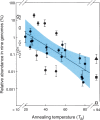Abundance and length of simple repeats in vertebrate genomes are determined by their structural properties
- PMID: 18687880
- PMCID: PMC2556271
- DOI: 10.1101/gr.078303.108
Abundance and length of simple repeats in vertebrate genomes are determined by their structural properties
Abstract
Microsatellites are abundant in vertebrate genomes, but their sequence representation and length distributions vary greatly within each family of repeats (e.g., tetranucleotides). Biophysical studies of 82 synthetic single-stranded oligonucleotides comprising all tetra- and trinucleotide repeats revealed an inverse correlation between the stability of folded-back hairpin and quadruplex structures and the sequence representation for repeats > or =30 bp in length in nine vertebrate genomes. Alternatively, the predicted energies of base-stacking interactions correlated directly with the longest length distributions in vertebrate genomes. Genome-wide analyses indicated that unstable sequences, such as CAG:CTG and CCG:CGG, were over-represented in coding regions and that micro/minisatellites were recruited in genes involved in transcription and signaling pathways, particularly in the nervous system. Microsatellite instability (MSI) is a hallmark of cancer, and length polymorphism within genes can confer susceptibility to inherited disease. Sequences that manifest the highest MSI values also displayed the strongest base-stacking interactions; analyses of 62 tri- and tetranucleotide repeat-containing genes associated with human genetic disease revealed enrichments similar to those noted for micro/minisatellite-containing genes. We conclude that DNA structure and base-stacking determined the number and length distributions of microsatellite repeats in vertebrate genomes over evolutionary time and that micro/minisatellites have been recruited to participate in both gene and protein function.
Figures


References
-
- Ahrendt S.A., Decker P.A., Doffek K., Wang B., Xu L., Demeure M.J., Jen J., Sidransky D., Decker P.A., Doffek K., Wang B., Xu L., Demeure M.J., Jen J., Sidransky D., Doffek K., Wang B., Xu L., Demeure M.J., Jen J., Sidransky D., Wang B., Xu L., Demeure M.J., Jen J., Sidransky D., Xu L., Demeure M.J., Jen J., Sidransky D., Demeure M.J., Jen J., Sidransky D., Jen J., Sidransky D., Sidransky D. Microsatellite instability at selected tetranucleotide repeats is associated with p53 mutations in non-small cell lung cancer. Cancer Res. 2000;60:2488–2491. - PubMed
-
- Applequist J., Damie V., Damie V. Thermodynamics of the one-stranded helix-coil equilibrium in polyadenylic acid. J. Am. Chem. Soc. 1966;88:3895–3900. - PubMed
-
- Bacolla A., Wells R.D., Wells R.D. Non-B DNA conformations, genomic rearrangements, and human disease. J. Biol. Chem. 2004;279:47411–47414. - PubMed
-
- Bacolla A., Pradhan S., Larson J.E., Roberts R.J., Wells R.D., Pradhan S., Larson J.E., Roberts R.J., Wells R.D., Larson J.E., Roberts R.J., Wells R.D., Roberts R.J., Wells R.D., Wells R.D. Recombinant human DNA (cytosine-5) methyltransferase. III. Allosteric control, reaction order, and influence of plasmid topology and triplet repeat length on methylation of the fragile X CGG.CCG sequence. J. Biol. Chem. 2001;276:18605–18613. - PubMed
Publication types
MeSH terms
Substances
Grants and funding
LinkOut - more resources
Full Text Sources
